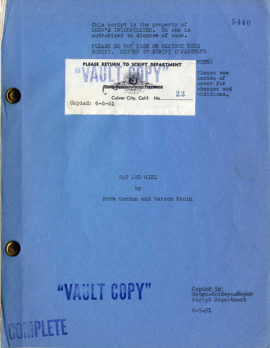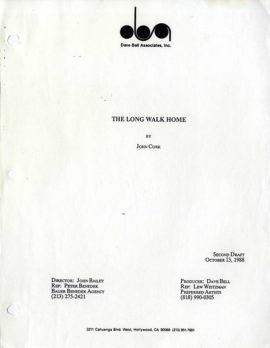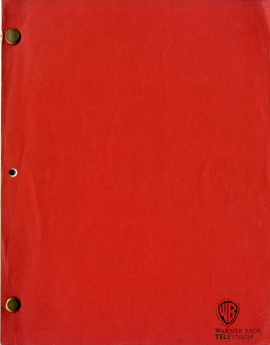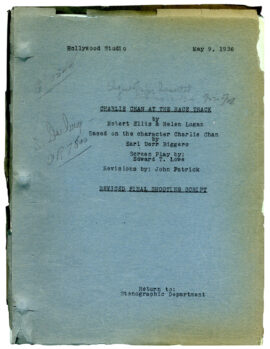





Harold Ramis (co-screenwriter, director) GROUNDHOG DAY (1992) Rainbow film script by Danny Rubin, Harold Ramis
[Los Angeles]: Columbia Pictures, 1992. Vintage original film script, 11 x 8 1/2″ (28 x 22 cm.), brad bound, 128 pp., a rainbow script with many pages of revisions on various colors of paper. Script belonged to Les Lazarowitz, the film’s sound mixer, who has added highlighting and underlining to various pages, as well as a few scattered holograph notes. Screenplay is credited to Danny Rubin and Harold Ramis, based on a story by Danny Rubin.
One of the funniest and best-loved comedies of the 1990s, Groundhog Day (Harold Ramis, 1993) tells the story of a cynical TV weatherman, played by Bill Murray, who is sent to the town of Punxsutawney, Pennsylvania, to cover the town’s annual February 2nd Groundhog Day event and, for reasons never explained, becomes trapped in a time loop where he is forced to relive the same day over and over.
It was the sixth collaboration between writer/director Harold Ramis and star Bill Murray, following their work together on hits like Caddyshack (1980), Stripes (1981) and Ghostbusters (1984), but unlike those earlier films, Groundhog Day is a story with genuine depth. The way the protagonist, Phil, has to keep reliving the same day, trying out different modes of behavior until he finally “gets it right”, parallels ideas of reincarnation and spiritual development found in Buddhism and other Eastern religions.
To begin with, Phil realizes the endless reliving of February 2nd gives him the freedom to do whatever he wants with virtually no consequences. He uses what he learns from day-to-relived-day to seduce women. At the story’s darkest point, believing there is no escape, he ends each day by committing suicide. What eventually saves Phil and frees him from the time loop is learning to live his life in the service of others.
The initial concept of Groundhog Day came from a spec script written by Danny Rubin. Rubin’s spec script began in the middle of the story, with Phil already in the town of Punxsutawney acting strangely, and the audience gradually learning (with the aid of voiceover narration) why Phil is doing what he does. Once Harold Ramis became interested in the project and brought it to Columbia Pictures, the studio demanded a more linear narrative, one where we meet Phil before he becomes trapped in the time loop. Ramis also eliminated the voiceover, as well as an ending in which Phil’s love interest, Rita, played by Andie MacDowell, becomes trapped in the time loop after Phil is freed.
The completed film is essentially Ramis’s rewrite of Rubin’s script, with some input from Rubin, and the occasional Bill Murray improvisation. An example of a Murray improv — after the film’s last line where Phil says to Rita, “Let’s live here,” Murray adds, “We’ll rent at first.” Ramis’s BAFTA Award-winning screenplay is a brilliantly constructed mixture of light and dark, of cynicism and affirmation, with nothing superfluous. Though fundamentally a linear narrative, Groundhog Day retains some non-linear elements. For example, Phil’s day-to-day attempts to seduce Rita are presented as a montage of brief scenes with variations. His repeated suicides by different methods are likewise presented as a montage of short scenes. The town itself is a principal character in the movie, and, like Phil, who at first thinks of them as “hicks,” we come to know and like each of the inhabitants individually. Harold Ramis was a filmmaker who liked people and believed in their potential to redeem themselves — even if it took several lifetimes to do so.
Out of stock




